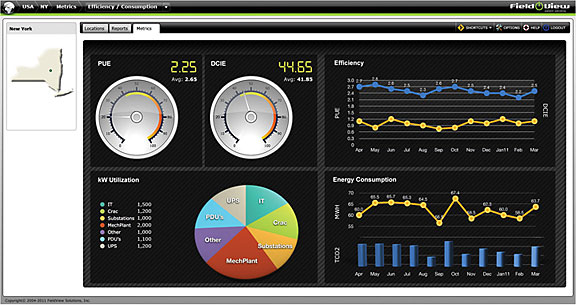Power utilization and monitoring of environmental factors are key issues for data centers. Telx, a New York City–based company that operates 15 data center collocation facilities in the U.S., has used FieldView Solutions’ Web-based data center infrastructure management software since 2009. Telx uses the software for power monitoring and for control of temperature and humidity in its data centers.
“We want to run our sites as efficiently and as green as possible,” says Mike Terlizzi, Telx’s vice president of operations. “Our main goal is to limit our overall power demand. Power utilization is one of the many metrics we use to measure efficiency.”
Terlizzi says FieldView Solutions is used by most of Telx’s facilities and will be in all of them by the end of the year. Telx operates four facilities in the New York metro area, two in Chicago, three in California (Los Angeles, San Francisco and Santa Clara) and other facilities in Atlanta, Miami, Phoenix and Charlotte, N.C. The company serves more than 900 customers.
“This tool in particular allows us to meter all the energy used on the customer’s side and for the equipment used to support that customer’s load,” Terlizzi says. “We can see real-time reports on how well we are doing to support that initiative and make sure we are fully leveraging capacity, not stranding power at different levels.”
Terlizzi says FieldView Solutions software allows Telx to monitor at a “granular” level, down even to the cabinet level.
“By having that level of granularity, we can focus our cooling to support a specific area rather than flood the data center,” Terlizzi says. “This helps us improve the power utilization of the data center. We can see how we are performing. It brings us closer to the customer and gives a far greater understanding about how we are using power. At this point we are very satisfied with the product suite. We have an effort to integrate it with some of our other data center management tools to give customers a holistic view on inventory. The flexibility is greatly appreciated.”
Look for Telx to add more facilities. Terlizzi says the company has an aggressive expansion plan in 2011 and beyond.
Cabinet-Level Care
FieldView Solutions’ customers primarily come from the financial services and collocation sectors.
“All of our clients have an extremely large footprint in terms of power consumption,” says Fred Dirla, FieldView Solutions’ CEO.
Dirla says product upgrades come under the direction of the company’s chief strategy officer David Schirmacher, who came to the company from Goldman Sachs. FieldView also bases software updates on direct customer input. Customers typically ask for software to produce more reports, more metrics and easier navigation.
“For example, if Telx says we would like the application to do A, B and C, that feature becomes part of the application,” Dirla says.
FieldView works 18 months to two years out in its product development, and for the last several years has averaged two major upgrades per year.
“We control our clients’ electrical capacity so they don’t build in more than they need,” Dirla says. “We manage data centers right to the razor’s edge. By utilizing floor space and managing cooling and lighting, they can build their facilities to have full redundancy. We take the power stream all the way to the cabinet level.”
Dirla says FieldView will continue to add more capabilities in data center management.
“We are going to be sliding down that continuum, focusing more on access management and networking routers, either through acquisitions or building from within. Our growth will come from the collocation sector and from the government, where we will probably be closing a deal with the Department of Defense. We will also see growth in the financial sector.”
Dirla says the Northeastern U.S., with a strong power grid, is a favorite location of companies with data centers serving the U.K. He cites Atlanta, Chicago, Texas and Colorado as key growth areas for data centers, primarily for the resiliency of the power systems in those areas.
“Companies look at whether a data center is going to be safe, and then they look at areas where the power is clean and consistent,” Dirla says.
